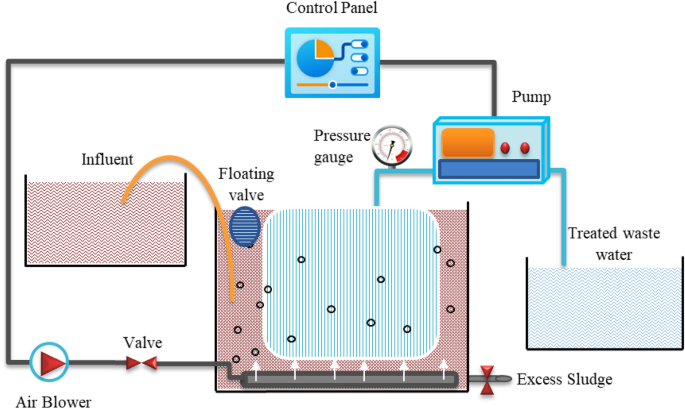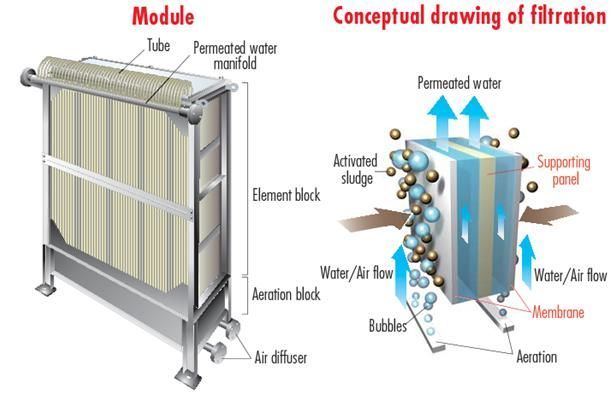Why Membrane Bioreactor Solutions Are Ideal for Sustainable Water Treatment
Why Membrane Bioreactor Solutions Are Ideal for Sustainable Water Treatment
Blog Article
Just How Membrane Bioreactors Are Revolutionizing Water Filtration Solutions
The emergence of membrane bioreactors (MBRs) stands for a substantial development in the area of water purification, combining organic therapy processes with advanced membrane filtration innovations. This integration not only enhances the high quality of dealt with effluent yet likewise addresses metropolitan area restrictions, making MBRs especially suitable for largely populated areas. As international water deficiency magnifies, the duty of MBRs in facilitating safe and clean water reuse and sustainable water administration becomes significantly crucial. The effects of this technology extend past performance-- what difficulties and possibilities lie ahead for its prevalent implementation?
Overview of Membrane Bioreactors
Membrane bioreactors (MBRs) represent a substantial development in water purification modern technology, as they integrate organic treatment processes with membrane purification. This assimilation boosts the effectiveness of wastewater treatment by utilizing microbes to break down natural toxins while simultaneously utilizing semi-permeable membranes to different treated water from suspended virus and solids.
The MBR system commonly includes an organic reactor where the microbial populace metabolizes impurities, complied with by a membrane filtering device that preserves biomass and permits just clean water to go through. This double functionality causes greater effluent quality contrasted to standard therapy approaches. MBRs can be operated in both batch and continuous flow settings, using adaptability in style and application.
They also allow the recuperation of water for reuse, hence adding to water sustainability efforts. Generally, MBRs are at the center of improving water treatment efficiency and top quality, showcasing the capacity for cutting-edge remedies in ecological administration.
Advantages of MBR Modern Technology
The combination of biological treatment with membrane purification provides numerous advantages for water filtration procedures. One of the main advantages of Membrane layer Bioreactor (MBR) technology is its ability to successfully get rid of both inorganic and organic impurities, resulting in high-quality effluent. The membrane layers function as a physical barrier, protecting against suspended solids and pathogens from passing through, which enhances the total security and reliability of cured water.
In addition, MBR systems call for a smaller sized footprint compared to standard treatment methods, enabling for extra effective space application. This portable design is particularly helpful in metropolitan setups where land is restricted. MBRs additionally show functional adaptability, accommodating differing influent qualities and circulation rates without significant performance destruction.
In addition, the procedure offers boosted nutrient elimination capacities, especially for nitrogen and phosphorus, which are important for stopping eutrophication in receiving waters. The reduced sludge manufacturing connected with MBR innovation likewise equates to reduce disposal prices, making it a cost-effective solution in the future - Membrane Bioreactor. On the whole, the advantages of MBR modern technology position it as a leading choice for innovative and sustainable water purification systems, addressing both environmental and economic concerns
Applications in Water Purification
Applications of Membrane Bioreactor (MBR) innovation in water filtration are diverse and impactful, resolving numerous treatment needs throughout several fields. MBRs successfully combine organic therapy procedures with membrane purification, making them perfect for municipal wastewater treatment, commercial effluent administration, and also safe and clean water reuse campaigns.
In community setups, MBRs are significantly used to boost the top quality of treated wastewater, permitting conformity with rigid discharge laws and facilitating the recycling of water for watering and non-potable uses. Their small design additionally makes them suitable for city environments where space is restricted.
Industrially, MBR modern technology is used to treat process water and wastewater, particularly in sectors such as food and beverage, pharmaceuticals, and textiles. By effectively eliminating impurities and put on hold solids, MBRs assist markets reduce environmental impacts while recouping beneficial sources useful link from wastewater streams.
Additionally, MBRs are getting traction in decentralized water treatment applications, where small systems can be released in remote areas or developing regions. This versatility enables communities to attain lasting water administration solutions, boosting accessibility to clean water while decreasing dependence on typical treatment methods.
Instance Research Studies and Success Stories

In one more instance, a textile production center in Bangladesh adopted MBR modern technology to address its wastewater obstacles. The system decreased chemical oxygen need (COD) levels from 1,200 mg/L to much less than 100 mg/L, therefore fulfilling regulative criteria and substantially minimizing ecological impact.
The College of Cape Town's MBR setup has actually shown reliable in treating greywater for non-potable Learn More Here reuse on university. This project not only preserves drinkable water yet also functions as an instructional model for lasting practices.
Additionally, a fish and shellfish processing plant in Norway used MBR modern technology to treat effluents consisting of high degrees of organic matter, attaining over 90% pollutant removal. These situation researches underscore MBR innovation's convenience and its vital function in improving water top quality across diverse applications.
Future of Water Treatment Solutions
As worldwide water deficiency and pollution challenges heighten, cutting-edge water therapy solutions are ending up being progressively important to ensure sustainable access to clean water. The future of water treatment depends on the combination of sophisticated modern technologies that boost the performance and performance of filtration procedures. Membrane layer bioreactors (MBRs) go to the center of this advancement, incorporating organic therapy with membrane layer purification to generate high-grade effluent ideal for numerous applications.

Emerging fads such as source healing from wastewater, including nutrients and energy, will certainly better change treatment facilities right into green centers. Developments in nanotechnology and membrane products guarantee improved efficiency and durability of filtration systems.

Conclusion
Their role in drinkable water reuse and lasting water monitoring highlights their significance in attending to international water scarcity challenges. Continued study and growth will even more improve the efficiency and fostering of MBR technology, guaranteeing a durable future for water therapy options.
The appearance of membrane bioreactors (MBRs) represents a considerable improvement in the area of water filtration, combining organic therapy procedures with sophisticated membrane layer purification modern technologies. As global water scarcity magnifies, the function of MBRs in helping with drinkable water reuse and lasting water administration ends up being index progressively important. They additionally allow the healing of water for reuse, therefore contributing to water sustainability initiatives.As global water scarcity and pollution obstacles intensify, cutting-edge water therapy options are ending up being progressively vital to guarantee sustainable accessibility to tidy water. Their function in potable water reuse and lasting water monitoring highlights their value in dealing with global water deficiency obstacles.
Report this page